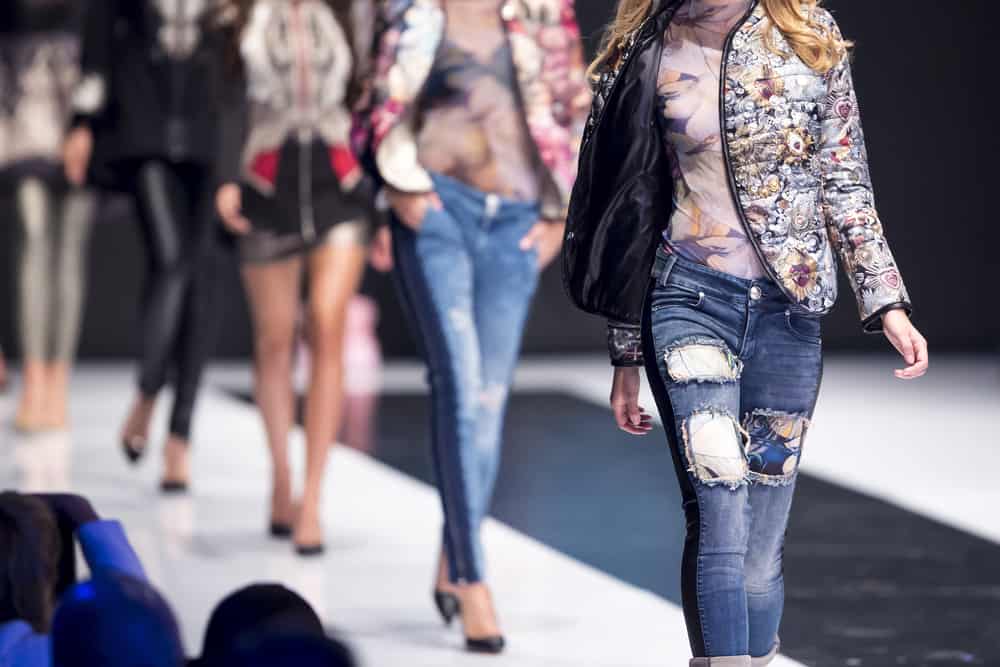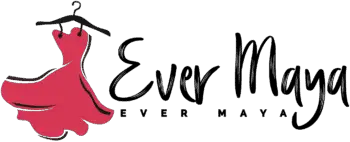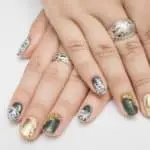Fashion design is arguably one of the most influential types of artistry around today, because it directly impacts what we wear and how we view each other on a daily basis.
There are many great paintings that hang on gallery walls, and great statues that stand in city plazas, however, the designs that walk up and down catwalks during fashion week filter down through an industry tier system until they end up in our closets and clothes drawers.
It is this very tier system that we are going to explain in this article. So, if you are interested in becoming a fashion designer, entering the fashion industry, or simply interested in fashion, then read on to find out all about the 5 tiers of fashion design.

What Are The Five Tiers Of Fashion Design?
The five tiers of fashion design form what is essentially a hierarchical system, according to which the perceived ‘value’ and artistry of fashion designers and their garments is understood. Each tier has a different emphasis and target audience, and a different style of working.
Though all the following types of fashion design create and produce clothing, the methodology and approaches are very different, and so are the resulting price tags!
The five tiers of fashion design are:
- Couture or Haute Couture Fashion
- Luxury Fashion
- Ready-to-wear or Prêt-à-Porter Fashion
- Fast Fashion
- Economy or Disposable Fashion
As a general rule, the quality of the fabrics and construction of the garments diminishes as the tiers progress, whilst the number of garments produced increases. Because people tend to place more artistic value on what is rare and singular, the price tag goes down as the number of garments increases.
Put simply, haute couture fashion produces a small number of high quality, highly expensive garments each year, and economy fashion produces a high number of low quality, very cheap garments each year.
Luxury fashion, ready-to-wear and fast fashion make up the tiers of a sliding scale in between.
Of course, art is subjective and therefore the ‘artistic worth’ of these different types of fashion design is entirely personal.
There is a level of crossover between the tiers and it is possible for one fashion house, designer or brand/company to produce garments that fall into different categories. What is clear is that all the tiers are interlinked and highly influenced by each other.
What Exactly Is Fashion Design?
Fashion design is, most simply, the art of creating clothing garments and accessories. The purpose and emphasis of the garments that are made can vary hugely. Some fashion design focuses on art and aesthetics, some on functionality and accessibility.
Human beings have always used clothes to display social status and express personality. Throughout history, laws have been passed to dictate what clothes people can and cannot wear because garments hold such power and sway.
In fact, social, political and cultural history can actually be plotted just by looking back through our ever changing clothing trends. What is more, clothes keep our bodies warm and protected and have to be flexible and comfortable enough to wear every day.
Fashion design encompasses all these facets and is therefore an incredibly important art form.
What Is The Fashion Industry
When people talk about the fashion industry they are referring to the entire clothing creation enterprise and all the different processes within it. From individual designers, to fabric merchants, to seamstresses in sweatshops and factories, to huge high street shopping chains.
Anyone or anything that is connected to the world of fashion and makes money from designing, producing, distributing or selling clothes falls under this giant umbrella.
Fashion is one of the wealthiest and most fast growing industries in the world – and it also happens to be one of the worst contributors to climate change as a result.
What Do Fashion Designers Do?
Fashion designers are responsible for coming up with the ‘ideas’ for clothing garments, and for subsequently converting their ideas into workable designs.
Though many fashion designers can sew, it is not actually a requirement that they be able to as they have seamstresses and dressmakers to do that bit.
Fashion designers need to have knowledge of fabrics and sewing techniques in order to create fully formed designs which take texture, weight and construction into consideration.
They have to have an eye for color, shape and pattern, as well as an understanding of any practical or functional elements of their designs.
Fashion designers are generally creative, artistic and very hard working (because the industry is highly competitive and you don’t get far without a lot of drive).
There are some designers who are so successful that they are famous, and have fashion houses and businesses of their own. Other fashion designers work anonymously for large brands, creating designs that they will not be personally accredited for.
Some fashion designers work alone in small, boutique shops and businesses, whilst others will be part of a big team, collaborating on designs and collections.
In these companies, designers may not be responsible for garments but rather step in and make alterations and tweaks to existing garments.
The 5 Tiers Of Fashion Design Explained

TIER 1. Haute Couture Fashion Design
Haute couture (or just ‘couture’ as it is sometimes called), sits at the very top of the fashion design food chain. This type of design is extremely elite, high quality and expensive. In terms of ‘artistic value’ and ‘monetary value’, haute couture garments top the bill.
What Is The Emphasis Of Haute Couture Design?
In haute couture fashion design, the emphasis is strongly placed on art, with the originality, beauty and concept of the garments being of foremost importance. These pieces can be wacky, provocative and seriously impractical, and are often described as ‘walking works of art’.
Designers can convey particular social or political messages through their garments, tell stories and evoke emotion, just as painters, sculptures, composers and writers aim to. They will also respond to their customer or model’s specific body type, character and input.
Who Is Haute Couture Aimed At?
Haute couture garments are custom made one-off garments. They are usually made for a single paying customer or for a fashion show, and are always fitted exactly to the measurements of the body they will be worn on.
As the emphasis of haute couture is art and aesthetics, these garments are often not very practical and are made for special occasions or fashion events. Because these garments are singular and unique, they come with a very high price tag.
Haute couture is therefore almost exclusively worn by the wealthy elite.
What Is The Process Of Haute Couture?
Since 1945, Fashion houses have to have been designated by the French Government in order to qualify as ‘haute couture’. They must have a workshop in Paris, employ at least 15 employees full-time, and they have to release at least 35 new garments to the public twice a year.
Haute couture designers therefore work with a large team of talented and highly skilled seamstresses to create each of their looks. They will use the best quality fabrics, beads and threads, and a single garment can take hours upon hours of handcrafting to complete.
The finished articles are detailed and completely unique.
TIER 2. Luxury Fashion Design
Luxury fashion sits neatly between the exclusive world of bespoke garments, and the mass production of ready-to-wear garments. The quality of the materials and fabrics used tends to be very high in luxury fashion, yet the items produced are not one-offs as they are in haute couture.
What Is The Emphasis Of Luxury Fashion?
The emphasis of luxury fashion is just that – luxury. Quality tailoring, fabrics and designers all elevate these designs and mean that luxury brands carry status and appeal.
Style, class and relevance all play a huge role in luxury designs, and they often set the trends that ready-to-wear and fast fashion follow. Luxury fashion is all about quality and exclusivity, without being made-to-measure.
Who Is Luxury Fashion Aimed At?
Luxury fashion designs are not singular items, but they do tend to be made in limited quantities rather than mass produced. The items are therefore more expensive because they are rare, and people desire these items for their exclusivity as much as for their quality and look.
Luxury garments often come with a high price tag that excludes many people from being able to buy them. It is the wealthy elite who tend to shop in luxury fashion stores.
What Is The Process Of Luxury Fashion Design?
The creation of luxury fashion items involves talented designers taking inspiration from cultural and social trends, and creating looks that are at the cutting edge of fashion.
These looks are then made by talented seamstresses in high quality fabrics, with multiple garments produced although not so many as to diminish the value of the brand. These garments are then sold at a high price in exclusive stores, fashion houses and boutiques.
Luxury garments tend to be released in ‘seasons’ or ‘collections’ rather than as individual garments and are renewed several times throughout the year.
Tier 3. Ready-To-Wear Fashion Design
Below luxury fashion in the hierarchy of design sits ready-to-wear fashion. Ready-to-wear garments are the kind of garments most commonly seen in high street stores and online retailers, and are probably what you have in your closet.
What Is The Emphasis Of Ready-To-Wear Fashion Design?
Ready-to-wear fashion is all about mass appeal. The garments we see in our stores and online are all trying to recreate the trends and looks that more expensive and exclusive designs achieve, but also be practical to wear in day-to-day life and affordable enough for people to buy.
Ready-to-wear is all about designing clothes that look good, feel good and reflect the trends of the day, at a price that the average consumer can afford.
Who Is Ready-To-Wear Aimed At?
Ready-to-wear garments are aimed at the average consumer and are therefore mass produced in standardized sizes.
Rather than being made-to-measure, with a person’s individual body measurements in mind, ready-to-wear garments use generalised sizings in order to fit more people.
Most people know what ‘dress size’ they are as well as they know what ‘shoe size’ they are. It is these sizings that make mass production possible, and make garments ready to be worn straight off the hanger, with no alterations or tailoring at all.
As a result, these garments are less expensive than haute couture and luxury items and affordable to most people.
What Is The Process Of Ready-To-Wear Fashion Design?
Ready-to wear garments are generally designed by a team of designers who are not individually accredited by work anonymously within a company.
Some luxury fashion houses create both haute couture and ready-to-wear collections, although the designs are very different from each other.
Ready-to-wear designs have a much faster turnover than haute couture or luxury clothes and are therefore released more regularly, with new garments being added to stores around every few weeks.
Due to the fast turnover, the designs have to be simpler and less labor-intensive to produce. The quality of the fabrics is less high than that used in luxury designs, and the price of the garments is reduced as a result.
Ready-to-wear fashion is also known as high street fashion or prêt-à-porter and it is therefore found in most high street stores.
Tier 4. Fast Fashion

Fast fashion is the term that applies to most of the apparel in stores and online today. It is the process of recreating designer and luxury trends in as quick and cheap a way as possible, and selling as many garments as possible in order to generate profit.
Fast fashion has come under lots of scrutiny lately due to its negative impact on the environment and climate change.
What Is The Emphasis Of Fast Fashion?
Fast fashion is all about recreating looks that are displayed on high fashion catwalks as cheaply and quickly as possible. It aims to be aesthetically appealing, trendy, relevant and … fleeting.
Because, the faster fashions move on, the sooner consumers feel the need to buy new garments. Fast fashion purposefully churns out a huge number of new looks and items at a very high turnover rate in order to coax customers into buying more clothes.
The emphasis of fast fashion is firmly pointed towards profit.
Who Is Fast Fashion Aimed At?
Fast fashion is aimed at the average consumer who likes to keep up with new trends but does not have thousands of dollars to spare.
It makes attractive and stylish items available to everyone, but also keeps consumers on a constant hamster wheel of trying to keep up with changing trends.
The clothes that are produced are often much more dialed down versions of the designs seen on catwalks and magazines, and this is specifically so that they appeal to more people and can therefore be sold more widely.
What Is The Process Of Fast Fashion Design?
Fast fashion involves designers copying and adapting high fashion looks and trends and converting them into much more simplistic versions that can easily be mass produced.
This process happens incredibly quickly (hence the name), so that catwalk designs are often recreated in fast-fashion-form within one or two weeks of being seen.
The simplified designs are sent to factories for mass production and are then distributed via trucks and airplanes all over the country and indeed the world. The environmental impact of mass producing and distributing these garments is devastating.
The designs only spend a few weeks on shop floors before they are replaced by new designs at a high turnover rate.
Tier 5. Economy Fashion
On the lowest rung of the fashion design ladder sits economy fashion. This type of design is all about affordability, functionality and accessibility.
Unfortunately, economy designs are cheap for a reason, and the materials and techniques used are often very low quality, with the workforce employed to make them being badly underpaid.
What Is The Emphasis Of Economy Fashion?
Where haute couture focuses on artistry, luxury fashion focuses on exclusivity, ready-to-wear and fast fashion focus on mass appeal and current trends… economy fashion is all about affordability and profit.
The designs are functional, simplistic and often rudimentary in order to serve the basic purpose of covering people’s bodies. The sizings are broad and standardized in order to be relevant to the largest possible market.
The fabrics are cheap and often low quality so that they do not last long.
This is not just so that the garments can be kept affordable, but so that they need replacing quickly (thus generating more profit for the company).
Who Is Economy Fashion Aimed At?
Economy fashion is aimed at anyone who does not have the money to pay for expensive and fashionable clothes but who still needs garments that meet the basic needs of everyday wear.
It is also aimed at those who do not care for fashion or changing trends and want to buy the most simplistic and cheap items possible in order to spend their money on other things.
This type of fashion design is also aimed at large capitalist investors who look to create profit by making garments as cheaply as possible and selling them in extraordinarily high numbers.
What Is The Process Of Economy Fashion Design?
Economy fashion has recently acquired a new name – disposable fashion.
This relates to the fact that the clothes that are made are so poorly constructed that they fall apart quickly, or so cheap to buy that they can be tossed in the trash with little thought and replaced very swiftly for little expense.
These designs are manufactured overseas by underpaid workers who receive none of the vast profits that this kind of business generates.
The garments are designed and mass produced at such a high turnover rate, many of the garments are not actually sold and end up being thrown into landfill sites in developing countries.
Economy fashion is having a terrible impact on climate change and making a large profit for a few very select individuals. Whilst it is important that clothes are made affordable for everyone, it should not be at the expense of the workers and the planet.
Final Thoughts
The 5 tiers of fashion design are all interlinked and influenced by each other enormously.
From the elite world of haute couture, to the mass production of fast fashion garments, fashion designers work tirelessly to create beautiful, functional and unique works of art that we can all enjoy as part of our daily lives.
- What Is Inseam And Why Does It Matter? - September 9, 2022
- Sneaker Ball Attire Ideas - September 7, 2022
- What To Wear To A Brewery - September 6, 2022



